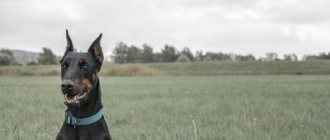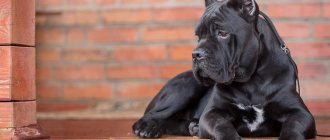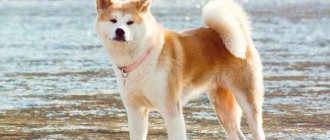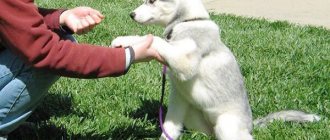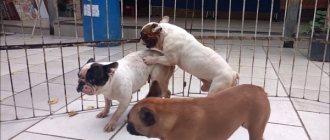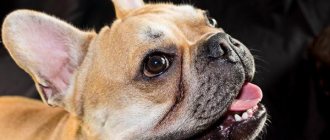The charming and sociable French Bulldog can be a great friend to anyone. Representatives of this breed are not averse to taking the place of a guard or a faithful hunting companion due to their intelligence and flexible nature. However, the main part of the advantages of the “Frenchman” is the merit of the owner, who tries with all his might to instill obedience in his dog. After all, deep in the dog’s mind there are signs of his ancestor – the stubborn and wayward English bulldog. Without proper upbringing, the “Frenchie” will fully display all the qualities of his ancestor, so before buying a puppy, it is important to get acquainted with how to raise a French bulldog.
How to raise a French Bulldog
Raising a Frenchman: theoretical foundations
A dog of any breed, including the Frenchie, owes its comprehensive development to the fact that it has a number of constant reflexes. They help the dog survive in any environment, and no trainer can achieve their extermination. On the contrary, attempts to suppress these reflexes will end in their strengthening.
When starting to raise any puppy, you need to take into account its unconscious desire for the following states:
- the desire to survive using the respiratory reflex;
- lack of hunger with developed sucking and chewing reflexes;
- reproduction with its hunt for individuals of the opposite sex and parental instinct;
- comfort in the form of warmth, a cozy home and physical health;
- peace of mind in the form of the ability to sleep or relax whenever you want;
- freedom in their actions: a puppy needs freedom in games, mental and physical development;
- regular communication with the owner or other dogs;
- security thanks to a home where there are no irritants and fear;
- life in a pack, subordination: for domestic dogs, their new family becomes the pack, and the owner becomes the leader.
Some owners of French bulldogs claim that their pets smile when they like everything.
If at least one of these conditions is not met, there can be no talk of any education. For example, it is impossible to teach something to a hungry or frightened puppy. Only one of these reflexes - reproduction - tends to be destroyed. Thus, non-purebred individuals often go through painful and problematic childbirth, so they are castrated or sterilized.
Important! In a castrated dog, the desire to look for a female disappears after about 6 months, and the energy freed from this reflex rushes into another direction. It is important for the owner to direct him to training or sports games, otherwise the bulldog will devote all his energy to “eating” stress and begin to gain weight.
The need for exercise with your pet
Dogs respond well to training and education. You need to train your French Bulldog regularly, avoiding skipping and shirking. The French Bulldog quickly learns this or that command, but, if possible, tries to avoid performing it. Therefore, in the matter of education, the owner is required to be firm, patient, and demanding of the pet. Only in this case can you count on success.
Young bulldogs have irrepressible energy. It must be directed in a good direction, otherwise it threatens to develop into increased aggression and make the animal dangerous to society.
Regular exercise and physical activity will serve to strengthen the dog’s physical health, become a point of energy application, and help raise a devoted family friend.
“Two pillars” in education: encouragement and punishment
Positive reinforcement and negative reinforcement are the main methods of influencing the French Bulldog. In the process of rewarding, the owner shows the dog that it has correctly completed what is required of it. Punishment is used to stop unwanted behavior in the future.
A bulldog needs to be taught how to behave in public places; this often cannot be dealt with without punishment.
However, both methods must be approached consciously and carefully, because both excessive punishment and excessive encouragement can cause harm in education. The nuances of both methods are presented in the table.
Table 1. The need for encouragement and punishment of a French bulldog in the process of education
| Promotion | Punishment | |
| Why is it necessary | An obedient pet must be praised immediately after it has correctly followed an order or performed well in training. Thanks to regular rewards, the dog will learn that exemplary behavior is followed by a “yummy treat.” He is more likely to perform actions that earn the owner's approval. | The most acceptable method of punishment is a severe reprimand. The bulldog will understand that the owner is not satisfied with his behavior, and in the future he will try not to act like that. But it is necessary to punish immediately after the offense has been committed, otherwise the relationship between the action and the punishment for it will be lost. |
| What not to do | Pieces of treats with which the owner rewards the pet should be changed regularly. Otherwise, the same “yummy” food ceases to be a desired reward for one’s efforts. Variety makes training enjoyable and not boring. | Under no circumstances should you beat a dog, even for the most serious offense. The pain caused to the pet will definitely return to the owner, because a frightened dog often behaves inappropriately - bites, scratches, attacks children. |
| Nuances | Positive reinforcement can include a kind word, an approving pat, a pat, or a treat. Most trainers use a treat as a reward, but some dogs prefer a favorite toy or affection from their owner. Before choosing a reward method, observe your dog's reaction to each of them. | You should not punish your dog too gently, otherwise the desired behavior will not be achieved. |
A small bulldog reaches out to its owner for a treat
Dog trainers claim that it is positive reinforcement that is the driving factor in shaping a dog’s behavior. But even the smartest dog will not be able to learn a command the first time, so repeated repetition is important in training. The trainer must maintain composure and be understanding of the dog's disobedience, slowly but persistently leading it to the desired result.
Important! If your dog's behavior doesn't change after punishment, keep an eye on him. Perhaps the punishment comes at the wrong time, and the pet associates it with another action. To prevent this from happening, it is necessary to punish within 2-3 minutes after the commission of the offense.
Possible problems
Most often, owners encounter aggression and disobedience in bulldogs older than 6 months. This is due to puberty. At this point, the dog may try to take a dominant position. Your job is to prevent this and demonstrate in every possible way that you are a leader. This involves resource allocation, patronage and consistency. For example, a good method for preventing dominance is training. Always ensure that the command is carried out. If the dog does not listen to you, sit or lay it down yourself. In this way, you will let her know that she will have to obey anyway, but she will not receive encouragement for such actions.
If a dog bites you while playing, stop playing and ignore the animal for 5-10 minutes; this will demonstrate that you do not intend to tolerate such behavior
Training a French Bulldog by character type
Some owners, instead of taking on the task of training a wayward French bulldog on their own, entrust this task to a professional dog handler. But there are also disadvantages to this approach: a dog that unquestioningly follows all commands from its trainer may forget about everything at home. She will return to stubbornness and reluctance to learn anything.
Therefore, it is still recommended to start training at home. But before starting lessons, you need to observe your pet to find out what type of character it is. After this, you can decide on the approach to raising a Frenchman.
French bulldog training
Choleric bulldog
Easily excitable bulldogs of the choleric nervous type require intensive work on inhibitory reflexes, as well as the development of endurance. Their training comes down to the following principles:
- Work without distractions. During training, you need to remove everything that can distract your excitable dog and throw him off balance. In addition, alternating excitation and inhibition is prohibited - for example, the commands “fetch” and “fu” should not follow in order.
- Training is not a game . For choleric bulldogs, the playful manner of training is not relevant; in such an environment it is impossible to teach them anything.
- Discipline. The framework of discipline should be outlined for the excitable dog, which must be strictly observed. You need to talk calmly, give orders clearly, and measure praise and punishment correctly.
During training with a choleric person, the trainer remains absolutely calm, all movements must be smooth. Success can only be achieved with regular exercise, preferably daily.
A French bulldog with a choleric character can run away from its owner in pursuit of a bird, cat or other living creature, so you should not let it off the leash
Phlegmatic Bulldog
Slow phlegmatic people need to be raised completely differently. So, too active and varied training is not suitable for them, since from overload with commands they can become inhibited and completely stop responding to orders.
A phlegmatic bulldog would rather lie down cuddled with a toy than carry out commands
A completely exhausted phlegmatic dog can simply lie on his back and refuse to do anything, demonstrating with all his appearance that he is indifferent to everything that is happening around him. After this, training must be stopped immediately, because it will be pointless.
The most important thing that is required from a trainer is sensitivity, gentleness and tact. He will have to feel the dog’s mood at the moment and monitor how it reacts to orders.
French bulldog listens attentively to his owner
Simple tasks followed by increased encouragement can arouse interest in learning among phlegmatic people. Gradually, the tasks become more difficult, and each completed command is generously rewarded with “yummy food.” With this approach it is possible to stir up the dog. In addition, the experience of dog handlers shows that phlegmatic puppies are best trained in a group with choleric peers.
Important! It is recommended to raise phlegmatic bulldogs in an apartment, as they suffer greatly if they fall into the hands of someone else’s trainer, even for a short time. Moreover, a stranger will not be able to establish contact with the dog.
Sanguine Bulldog and Melancholic Bulldog
Completely different types of temperament that require completely opposite methods of education. If sanguine people are smart and quick to learn, then melancholic people are inhibited individuals who are not inclined to train. The differences between them are presented in table form.
Table 2. Peculiarities of raising melancholic and sanguine types of French bulldogs
| Sanguine | Melancholic | |
| Attitude to training |
|
|
| Nuances | The sanguine French bulldog can be called an exception. This type of temperament is extremely rare among representatives of the breed, so the owner who gets an obedient and intelligent bulldog is a real lucky one. | The nuances of the sanguine French Bulldog can be called an exception. This type of temperament is extremely rare among representatives of the breed, so the owner who gets an obedient and intelligent bulldog is a real lucky one. The most resistant to training type of temperament. Despite this, a melancholic bulldog can be taught a set of basic commands if the owner has patience. The four-legged dog can follow commands to obtain praise from humans. |
A pitiful expression on the face is a common practice for a melancholic bulldog
First aid for an attack
What to do if your dog has an epileptic attack:
- If possible, you should place soft bedding under your pet. If the dog is large and it is impossible to lift it, only the head area is protected.
- You cannot unclench your pet's jaws; the muscle spasm can be so strong that the dog can injure the owner or itself.
- If possible, the animal's head should be laid to one side so that the dog does not choke on the vomit.
- There should be no bright light or loud sounds in the room.
- Speak calmly and do not make sudden movements.
If seizures have happened before, it is worth keeping a special notebook where you can write down all the factors in as much detail as possible: what the seizure looks like, when it happened before, how long it lasted. It may be possible to identify some patterns or seasonality in which this condition develops.
A pet that has already encountered epilepsy is monitored more carefully in order to identify the prodromal stage in time, when the animal begins to whine, hide, and becomes more nervous. Seizures occur more often in the early morning or late evening.
Expert opinion
Kuzmenko Olga Olegovna
If the attack lasts more than half an hour, you cannot wait, as status epilepticus may occur. In this case, you need to call a doctor or go to the clinic yourself.
General principles of development and upbringing of a puppy in stages
The formation of the character and behavior of a French bulldog occurs over several main stages. At the beginning of life, each stage helps to learn more about the future character of the pet. For a mature dog, the stages are associated with gaining life experience and the readiness to learn certain commands - from simple to complex.
The cute French Bulldog can look very tough if he wants to.
Stage 1. Start of life
Initial development occurs from 1 to 6 weeks of a puppy's life. This period is characterized by:
- Up to 14 days: complete dependence on the mother, desire to constantly sleep or be warm.
- Up to 3 weeks: strengthening of the sucking reflex. From the moment it is born, the puppy has a sucking reflex, which allows it to quickly find the mother's nipple and actively drink milk. During this period, experts are able to determine the future character and degree of energy of the bulldog by how actively it sucks milk.
Very small French bulldogs with their mother
- After 3 weeks: development of visual and auditory perception of the environment. In babies, vision and hearing begin to develop from the age of 15 days, and at 3 weeks the puppy can already move independently and maintain balance.
The puppy at this stage maintains a strong bond with his mother, so she is his main caregiver and influences him.
Important! At the end of the first stage, the breeder or the owner himself must carefully monitor the puppy’s behavior, noticing the most striking character traits. The baby should try to move more, look and smell the surrounding objects and explore the world by all available means.
Stage 2. Adaptation, getting used to the name
The age of 4 to 8 weeks is extremely important for the development of conditioned reflexes. During this period, puppies begin to demonstrate the ability to acquire the first skills of life in an unknown world. He plays with his mother and the other kids, gradually learning the basics of discipline and communication.
During this period, the owner will have to:
- Make sure your dog's basic reflexes are working. A one-month-old puppy should follow its mother everywhere. Later, this reflex will manifest itself in relation to the person - the dog will learn to constantly follow him. If the puppy is lethargic and during this period has a hard time perceiving the environment, it will be difficult for him to interact in human society.
- Come up with a nickname for the bulldog and teach it to him. Usually babies come into the home at the age of two months, and it is at this time that you need to teach the puppy to respond to his name. You need to teach a nickname in such a way that it depends on something pleasant - for example, eating or playing.
At first the bulldog will listen to the name
- Instill in your dog the first skills of communicating with humans. Up to 2 months, babies are calm with strangers; fear manifests itself after 8 weeks. Puppies begin to hide when they see a person. Immediately after entering the house, you need to teach the dog to communicate with family members and friends, otherwise it will grow up too timid or, on the contrary, aggressive.
Choosing a name for a puppy and teaching it to a nickname is perhaps the most enjoyable and at the same time difficult part in raising a four-legged animal. How to do it? Read our special article.
Stage 3. Socialization, basics of training
French Bulldogs are very sociable animals that need a lot of interaction with people and other animals. It is between 8 and 12 weeks that they begin to be curious about other puppies, sniffing at them and barking provocatively.
So, the socialization of a small bulldog is the most suitable period for:
- Getting used to your hands. These are preparatory steps that will facilitate the education process in the future. The puppy must allow itself to be picked up, ears and teeth examined, turned onto its back and placed in a standing position.
- Learning simple commands. At about 2-3 months, it’s time to teach the four-legged commands “come to me,” “walk,” and “place.” Already at 4 months, the little Frenchman is able to cope with the implementation of more difficult orders, for example, “fu”, “no”, “sit”, “lie down”.
- Fighting aggression. Aggression can manifest itself in a child’s behavior, but many owners do not take it seriously. From puppyhood, a French bulldog must understand that there is a subordination between animal and human. When a puppy growls at its owner, there is no need to turn it into a joke: such behavior must be eradicated immediately.
- Dosing caresses. Because of its charming face and friendly nature, the French bulldog often becomes the object of endless caresses, stroking, and lisps. Uncontrolled manifestations of love will only do harm, turning the four-legged dog into a capricious, spoiled dog.
Babies aged 2 to 3 months suffer from increased excitability and a shaky psyche. More than ever, the owner’s attention and his careful attitude in stressful situations are important to them.
A small dog should feel comfortable in the arms of its owner.
Stage 4. Struggle for leadership
At 3-3.5 months, puppies, not yet weaned from their mother and brothers, begin to fight for leadership with their peers. If at this age the baby is already in a new family, he tries to dominate the person.
The main task of the owner is to show that he is the dominant one, the leader, who should be obeyed. Otherwise, the dog will decide to try on the role of leader, and as it grows up it will only strengthen in this position. The submission process occurs according to certain rules, which are presented in the table below.
Table 3. Peculiarities of subordination of the French bulldog
| Way | Description |
| Ban on biting | A teenage bulldog will definitely find out at the first opportunity who is the leader in the house. During the game, he may snap or bite his owner. But if he reacts with dignity every time, the baby will gradually begin to take the position of a subordinate. |
| Control while walking | When walking, you need to pay special attention to how the dog reacts to the owner’s demands. You should not allow the leash to be pulled in different directions, thereby dragging the person along with you. To avoid this, the commands “fu” and “no” are used while simultaneously patting the dog’s butt. Gradually she will understand that she cannot behave as she wants. |
| Close contact | As a result of long-term communication between the owner and the bulldog, close emotional contact should be established between them. They begin to understand each other better, the animal reacts to the slightest change in the owner’s mood. If the upbringing was carried out correctly, the bulldog, already at 3 months of age, finally recognizes its owner as the leader. |
| Regular training | During this period, the growing “Frenchie” needs daily training and energetic games in the fresh air. The trainer repeats with him the orders “come to me”, “sit”, “stand”, “lie down”. Ball and frisbee games are practiced. The load should be added gradually - both physical and psychological. |
| Buying a collar with a leash | 13 months is the age when you can buy a collar and leash for your puppy. The collar should be soft, comfortable and wide. Accustoming to the equipment occurs gradually along with the command to “walk” and encouragement with “sweets.” |
The experience of breeders shows that 3 different types of relationships can be established between the owner and the bulldog: human leadership, leader dog and equality between man and animal. For those who want to raise a pet in accordance with all canine laws, the only correct decision should be the unconditional recognition of the person as a leader.
A French Bulldog must obey its owner unquestioningly
Stage 5. Fighting fear
This period can occur between six months and 14 months, depending on the dog’s individual temperament, and can last 1-2 months. The dog begins to be afraid of various things that he previously accepted calmly. In addition, there is a fear of new, unfamiliar objects. The owner's goal is to help the dog overcome these fears and support it.
The problem is dealt with using the following algorithm:
- After the owner notices the bulldog’s fear, he gives the dog the command “stand.”
- A dog that freezes after a command may whine, showing its fear. The owner approaches the object that frightened the puppy and touches it with his hand.
- The person commands “come to me” and waits for the puppy to approach. If this does not happen, the command should be repeated in a persistent but soft voice.
- The owner must behave calmly, clearly demonstrating that he is not at all afraid of the object. When the puppy approaches, you need to let him make sure that the thing is not dangerous, allow him to examine it and smell it.
If the trainer behaves patiently and steadfastly, this feeling will immediately be transmitted to the dog, and he will calm down.
A dog easily fights fear with the support of its owner
Stage 6. Transitional age
The most difficult period in raising a dog, which begins at one year of age and can last about 3 years. The desire to dominate awakens in the animal again, he tries to find weak points in the owner’s character and take a leadership position in the house.
This period is also characterized by the following factors:
- sudden aggression of the dog towards those people and animals to whom it was previously friendly;
- growling or loud barking at friends who came to visit, although previously the bulldog calmly sniffed them and allowed himself to be petted;
- reaching puberty, which requires continued active play and training.
The owner and all family members during this period must stock up on self-control and perseverance. A bulldog that barks and lunges at guests should not be locked in a room. Dog handlers recommend giving the “place” command in such a situation and allowing the dog to remain in the company without feeling like an outcast. If it doesn’t work the first time, repeat the order again, but in a more stern tone.
An aggressive bulldog is dangerous to others
Friends also need to be warned about a difficult period so that they do not try to communicate with the four-legged first. “The Frenchman” must react to the guests himself. This way the owner will show the dog that he is on the side of the visitors and they require the same respect as family members.
Important! If during adolescence the dog behaves extremely inappropriately and it is not possible to calm it down, it is recommended to go to a specialist. An experienced dog handler will give advice or actually show you how to calm a bulldog. You can learn more about the causes of aggression in dogs in our separate article.
What affects life expectancy
How long French bulldogs live depends on their care, nutrition and attentive attitude of the owner.
Nutrition
How long do Pomeranian Spitz live at home?
A balanced diet is the basis of a pet’s health. The animal can be given specialized food, selecting it according to age and weight. It is also not prohibited to adhere to a natural diet.
In this case, you need to rely on a number of rules:
Meat makes up about half of all foods consumed. It can be boiled or given raw. It is advised to avoid pork. Fermented milk products are an integral part of the diet, with the exception of those that contain a lot of sugar. Animals cannot digest milk. Among vegetables, carrots, potatoes, zucchini are welcome
Also, the dog will not refuse boiled pumpkin. Pets love cereals, rice, buckwheat and millet are especially useful for them
You can carefully give apples, bananas and melons, observing the reaction. There is a risk of allergies
Weight
Excessive weight and obesity often accompany representatives of the breed. Dog owners should constantly monitor their animal's diet by counting calories. Otherwise, excess weight will lead to the development of diabetes, which will greatly undermine the pet’s health.
Care
The dog's ears need to be examined for parasites. It is better to do this after every walk, and if necessary, clean them.
You also need to monitor the condition of the paw pads: for calluses, cracks and other damage. Be sure to treat problem areas to prevent infection and spread of infection.
You also need to take care of your French Bulldog's teeth:
- clean;
- remove tartar and plaque;
- remove sick ones.
Periodically, you need to show your dog to a doctor who will assess the condition of his teeth.
Problems with the birth of puppies
French bulldog puppies have fairly large heads. At birth, the dog often has to undergo a caesarean section. It is extremely difficult to carry out it at home without negative consequences for the animal. To avoid complications and especially death, the operation must be performed in special clinics.
Castration and sterilization
Castration and sterilization can prolong the life of a French bulldog:
- Reduce the risk of cancer.
- Make pets calmer and more balanced. They do not constantly strive to run away from their owner, jump out onto the road, or fight with another dog.
Unsterilized girls can also show aggression and be disobedient.
Note! It is better to carry out the operation before the first heat. If the moment is missed, then you cannot sterilize during the period of active sexual desire; you need to wait until it ends
Physical activity
The animal must exercise a lot to eliminate the possibility of obesity. To do this, you need to walk the dog every day and encourage him to spend time actively. He will be happy to get involved in any game with his owner and other animals.
Active games
Lack of activity is fraught with:
- development of intervertebral hernias;
- atrophy of the limbs.
Emotional mood
The dog reacts to any emotions of the owner. She perceives shouting and scandals extremely negatively, which affects her health. A favorable environment at home, love and mutual understanding can prolong her life.
Practical skills: socialization, education, training
The upbringing of a four-legged animal is a multifaceted and ambiguous problem. Thus, a puppy who is trained not to climb on the table can be called well-mannered, but at the same time he will not understand a single command. A dog who ideally masters all commands will also be well-mannered, even if he begs or chews his owner’s things.
Therefore, experienced trainers recommend that owners of French bulldogs distinguish between 3 concepts that will help in mastering all practical skills. This:
- Socialization. This cannot be taught to a dog, but any owner can provide it with regular communication. The first skill that socialization develops is living in harmony with the world. This is what determines how the dog will be raised and trained. The owner will have to help the puppy satisfy all its needs without entering into conflict with the outside world, otherwise the dog will be timid and incapable of acquiring knowledge. In practice, socialization comes down to simple things - regular walks, games, travel, communication with people and animals.
- Upbringing. Another basic concept that means that the puppy should not climb on the table, bite, jump on a person, or leave puddles on the floor. This behavior is not fixed as a result of training, but comes with experience: the puppy, through his mistakes, understands how he can behave and how he cannot. Basic instincts play a big role here: it is difficult to get friendliness from a timid four-legged animal, and to react to orders from an exhausted one. How quickly the training will proceed depends not only on the persistence of the owner, but also on the innate qualities of the dog.
- Training. The only concept that includes training and education. By training a bulldog, a person teaches him to unquestioningly follow all orders. A stubborn bulldog needs the patience and perseverance of the owner, only if these factors are present will he be happy to please him.
A teenage bulldog plays with his owner, pressing himself to the floor and preparing to jump.
French bulldogs, who from birth have an unshakable calm psyche, are socialized faster and go through the training stage. Moreover, how effective training will be depends on motivation. It can be positive or negative: the dog follows the order - receives encouragement, does not follow the command - receives punishment.
Grown-up bulldogs feel comfortable in the car
When to start learning commands
When purchasing a puppy for the first time, many novice dog breeders wonder how to raise a French bulldog and when to start teaching commands. Experts unanimously say that you need to start training lessons from the first month or from the moment the animal appears in the house.
First of all, the French Bulldog needs to be taught commands such as “give” and “come to me.”
At a tender age, it is very important to choose the right approach and draw up a step-by-step plan so that training for a puppy is not associated with something strange.
For your information! It is recommended to begin serious training as soon as the dog reaches three months of age. However, you should not try to teach your pet all commands at once. You can only raise a puppy correctly gradually. With proper training, by six months the French Bulldog will know all the basic commands.
The French Bulldog turns into an adult dog by the age of 3
A well-mannered and trained French Bulldog will become a good companion and a favorite for the whole family. To achieve maximum results, training should begin from the first days the dog appears in the house. French bulldogs are very smart and quick-witted, but despite this, firmness and perseverance should be shown during the training process. Only in this case will the puppy grow and develop correctly. For beginner dog breeders today there are many manuals in which you can find a lot of useful information to facilitate the learning process.
Training a French Bulldog at home
So, we have already found out that the development process of a small French bulldog is filled with various difficulties and requires the close attention and sensitivity of the owner. It is preferable to raise and train representatives of the breed at home, so as not to traumatize the pet’s psyche by strangers. Training puppies and adult bulldogs has its own nuances and rules.
The French Bulldog can fetch thrown sticks on the command "fetch"
Origin
For the first time, the French bulldog appeared in France in the 19th century, when they were brought there by English settlers. Initially, the breed was considered exclusively decorative.
“Frenchies” became widespread by accident - one of the young aristocrats was walking with a pet along the Champs Elysees, and since he was the favorite of many young ladies, the dog was also noticed. Soon, these babies appeared among many young dandies who loved female attention.
At the beginning of the twentieth century, this breed appeared in Russia, but the high cost of such babies (comparable to a new car) did not allow ordinary people to have them. It is historically established that the daughters of Emperor Nicholas II had a French bulldog.
How to start training a puppy
You can’t force a puppy to train immediately after it arrives in the house. The four-legged animal needs to be given time to cope with the stress of changing its place of residence and to get used to the new conditions a little. Otherwise, excessive pressure will cause excessive timidity or the development of aggression.
At the initial stage, the dog should have a single owner who will give it maximum attention. If the friendship improves, the baby will begin to whine and worry in the absence of the owner, and react to his appearance with a joyful bark. Already at this time education begins:
- a small bulldog is forbidden to do everything that cannot be done as an adult (climb onto the bed, chew shoes, bite);
- begging is eradicated immediately; at the first attempts to ask for food during a family dinner, the dog is sent to the place;
- treats should not be given between meals; the treat should be a reward for the correct response to orders.
Baby French Bulldogs
Accustoming to a nickname
After the first rules of life in the house have already been outlined for the puppy, accustoming him to a name begins. It happens as follows:
- A person calls a dog by name during any contact with him - when he calls him to eat, play, or wants to praise him.
- Training is combined with the “come to me” command. Saying the name and then the order, you can sit down and call the four-legged animal with your hand.
- If the dog begins to respond and approaches, you need to hand him a piece of treat and stroke him.
What treat to give during training?
Over time, the treat is replaced with praise, otherwise, due to excessive feeding, the treat will cease to be desirable, and the bulldog will completely stop obeying.
A sociable bulldog is ready to communicate with everyone around him
Toilet training
A small bulldog has a very weak bladder, so it is better to remove all carpets from the floor during potty training. Instilling the skill of writing where needed lasts about 2-3 months. The algorithm will be like this:
- Buying a tray where the “Frenchie” will go in the first months of life. It should be planted in a pot immediately after waking up, after exercise, or some time after lunch.
- If the ward managed to go to the toilet, you need to praise him. Otherwise, let him go for a walk and try again after another 4-5 minutes. Over time, the four-legged dog will get used to it and will use the tray on its own.
- The baby will need time to get used to the new rules, so the owner needs to be patient and not scold the child for puddles on the floor.
- Up to 4 months, bulldogs have poor control over urination and may simply not have time to get to the toilet.
- In the future, control should be strengthened and more persistent. However, the owner needs to prepare for the fact that up to 8-9 months of age, the four-legged animal may inadvertently leave piles and puddles on the floor.
You need to praise your four-legged dog especially actively after he has gone to the toilet outside at the start of his walk. For several months he may defecate both in the apartment and on the street, and you need to prepare for this.
Teenage dog on a harness
Basic Commands
The list of basic training for a growing bulldog includes a whole range of exercises that are designed to provide him with a comfortable life in an urban environment. So, this basic list includes the following commands:
- "To me" . The instillation of the reaction is brought up from infancy, when the owner calls the dog to the bowl with this order. The phrase begins to be associated with pleasant emotions, and the little bulldog happily runs to the call. Then you can move to another room, and the role of “motivator” is played by a piece of treat in the hands of the owner. Once the exercise is established, you can practice it while walking.
- "Place". A small bulldog is placed on his bed after he has played or eaten, saying a command. After which you need to hold it in place for a few seconds, stroke it and praise it.
Bulldog performs the command "place"
- “Sit, lie, stand . During the exercise, the owner takes a treat and, with the help of it, gives the dog the desired position - he lifts the piece above his head so that the dog sits down or presses it to the ground so that he lies down. As training progresses, the commands become more complex - the dog is trained to lie down while walking or to stand up when approaching a person.
- “Ugh, no way . It is used when the puppy performs some prohibited action - if he took the owner’s slipper in his teeth, jumped on the bed, or grabbed a dirty stick on the street. The command is strictly pronounced, after which the owner shows what he wants from the puppy - he takes the stick, drives him off the bed, etc. You cannot reward a four-legged animal, even if it has completed what is required: the “fu” command should not be associated with something pleasant.
- "Place" . A small bulldog is placed on his bed after he has played or eaten, saying a command. After which you need to hold it in place for a few seconds, stroke it and praise it.
A representative of the breed demonstrates a stand at an exhibition
Aggression or play?
At the age of 2-3 months, puppies begin to bite, which causes shock and panic among owners.
All little puppies bite. Strong and painful. This is a normal stage of development. The pet will growl loudly and bite for some time. Usually all these bites are related to game moments. By about four months, the puppy will learn to play without biting.
True aggression is very rare in children and is almost always associated with severe fear. A puppy that bites out of fear tends to hide, growls quietly and tries to avoid contact before biting, while the playful one will initiate contact and growl more and more loudly.
Training an adult dog
If an adult French bulldog immediately appears in the family, the new owner will have to independently fill the gaps in education that the previous family made. A four-legged dog that is already accustomed to doing something that is strictly forbidden to do in a new home will have a hard time getting out of the habit. If the dog cannot be trained under any conditions, it is better to contact professional dog handlers.
Adult bulldogs can be very capricious, especially if not properly trained.
And those who decide to raise a bulldog on their own or continue training it from childhood should start training outside. Outdoor exercises are a very important part of training.
French bulldogs exercising while walking
Practicing basic commands on the street
In the first stages, all exercises will be much worse for the four-legged than in an apartment. This is facilitated by many distractions: cars, strangers, constant noise, and others. The rules for street training will be as follows:
- You should persistently but calmly repeat the command, not allowing the dog to ignore it.
- During the first months, it is forbidden to let the bulldog off the leash.
- You cannot allow a four-legged animal to pick up something from the surface of the soil or take it from the hands of strangers; such moments are immediately stopped by the command “no”.
If the dog successfully shows itself on the street and is not distracted when demonstrating commands, you can take it to the dog park. It is best if already trained dogs walk there. After the bulldog gets used to it a little, you can let him off the leash. Stairs, barriers and other exercise equipment on such sites will help the dog develop physically, and communication with his own kind will help socialization.
On the street you can train all the already known commands - “near”, “to me”, the “sit/stand/lie” complex and gradually supplement them with new exercises.
Practicing the “lie down” command
In-Depth Training
Bulldogs cannot be service or guard dogs, however some commands from a specialized course are available for them. So, the “Frenchman” can be entrusted with:
- fetching any object or favorite toy;
Little bulldog brings his toy
- protection of inanimate objects;
- searching for the owner by smell.
If desired, you can train a representative of the breed to perform sports exercises - for example, with the commands “crawl”, “snake”, “roll”.
To keep short-haired pets from freezing, owners buy warm jackets for them
However, the owner should remember that in-depth training is only possible with the participation of a professional dog handler due to the stubborn nature of the bulldog. Of course, you can try to train your pet yourself, but you still can’t do it without expert advice.
Stop biting
The owner must impose a strict ban on biting in the house and on the street. This rule should be introduced into everyday life from the age of two months. Even during play, the puppy should not be allowed to bite a person. The owner must show intolerance to the fact that the dog bites - with a stern reprimand, shouting. Soon the dog will stop doing this. If you do not indicate the prohibition initially, allowing the bulldog to grab arms and legs with his teeth, he will cease to feel the difference between play and aggression.
Number of meals
The diet for a puppy is different from that of an adult dog. The small pet is fed several times a day. After a year for a French bulldog, the number of feedings is reduced by three times. The dog's feeding regimen should be organized as follows:
- one and a half to two months: six times a day;
- two to three months: five times a day;
- three to six months: four times a day;
- six to twelve months: three times a day.
After the French bulldog turns one year old, it can already be transferred to two meals a day, increasing the daily volume according to the animal’s needs. An adult pet needs to be fed almost the same as a puppy. When feeding natural products, you need to give a vitamin and mineral supplement according to the age of the dog.
Once a year, or preferably once every six months, you need to visit a veterinarian for a general examination of your pet and receive recommendations on the correct use of feeding. Even when fed a commercial diet, your French Bulldog may need a high calcium and phosphorus supplement. For example, during the change of teeth, at three to six months.
The doctor can also help with diagnosing possible food allergies and timely treatment. As you know, French Bulldog dogs often have allergic reactions to various types of foods. An allergy can begin at any time and to anything: both in two months to a new product, and in a year to a long-familiar food.

